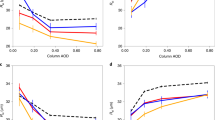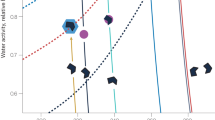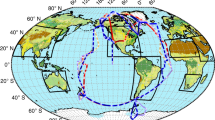Abstract
The amount of ice present in mixed-phase clouds, which contain both supercooled liquid water droplets and ice particles, affects cloud extent, lifetime, particle size and radiative properties1,2. The freezing of cloud droplets can be catalysed by the presence of aerosol particles known as ice nuclei2. One of the most important ice nuclei is thought to be mineral dust aerosol from arid regions2,3. It is generally assumed that clay minerals, which contribute approximately two-thirds of the dust mass, dominate ice nucleation by mineral dust, and many experimental studies have therefore focused on these materials1,2,4,5,6. Here we use an established droplet-freezing technique4,7 to show that feldspar minerals dominate ice nucleation by mineral dusts under mixed-phase cloud conditions, despite feldspar being a minor component of dust emitted from arid regions. We also find that clay minerals are relatively unimportant ice nuclei. Our results from a global aerosol model study suggest that feldspar ice nuclei are globally distributed and that feldspar particles may account for a large proportion of the ice nuclei in Earth’s atmosphere that contribute to freezing at temperatures below about −15 °C.
This is a preview of subscription content, access via your institution
Access options
Subscribe to this journal
Receive 51 print issues and online access
$199.00 per year
only $3.90 per issue
Buy this article
- Purchase on Springer Link
- Instant access to full article PDF
Prices may be subject to local taxes which are calculated during checkout




Similar content being viewed by others
References
Hoose, C. & Möhler, O. Heterogeneous ice nucleation on atmospheric aerosols: a review of results from laboratory experiments. Atmos. Chem. Phys. 12, 9817–9854 (2012)
Murray, B. J., O’Sullivan, D., Atkinson, J. D. & Webb, M. E. Ice nucleation by particles immersed in supercooled cloud droplets. Chem. Soc. Rev. 41, 6519–6554 (2012)
DeMott, P. J. et al. African dust aerosols as atmospheric ice nuclei. Geophys. Res. Lett. 30, 1732 (2003)
Murray, B. J., Broadley, S. L., Wilson, T. W., Atkinson, J. D. & Wills, R. H. Heterogeneous freezing of water droplets containing kaolinite particles. Atmos. Chem. Phys. 11, 4191–4207 (2011)
Lüönd, F., Stetzer, O., Welti, A. & Lohmann, U. Experimental study on the ice nucleation ability of size-selected kaolinite particles in the immersion mode. J. Geophys. Res. 115, D14201 (2010)
Pinti, V., Marcolli, C., Zobrist, B., Hoyle, C. R. & Peter, T. Ice nucleation efficiency of clay minerals in the immersion mode. Atmos. Chem. Phys. 12, 5859–5878 (2012)
Broadley, S. L. et al. Immersion mode heterogeneous ice nucleation by an illite rich powder representative of atmospheric mineral dust. Atmos. Chem. Phys. 12, 287–307 (2012)
de Boer, G., Morrison, H., Shupe, M. D. & Hildner, R. Evidence of liquid dependent ice nucleation in high-latitude stratiform clouds from surface remote sensors. Geophys. Res. Lett. 38, L01803 (2011)
Ginoux, P., Prospero, J. M., Gill, T. E., Hsu, N. C. & Zhao, M. Global-scale attribution of anthropogenic and natural dust sources and their emission rates based on MODIS Deep Blue aerosol products. Rev. Geophys. 50, RG3005 (2012)
Niemand, M. et al. A particle-surface-area-based parameterization of immersion freezing on desert dust particles. J. Atmos. Sci. 69, 3077–3092 (2012)
Connolly, P. J. et al. Studies of heterogeneous freezing by three different desert dust samples. Atmos. Chem. Phys. 9, 2805–2824 (2009)
Pratt, K. A. et al. In situ detection of biological particles in cloud ice-crystals. Nat. Geosci. 2, 398–401 (2009)
Glaccum, R. A. & Prospero, J. M. Saharan aerosols over the tropical north-Atlantic: mineralogy. Mar. Geol. 37, 295–321 (1980)
Vali, G. Quantitative evaluation of experimental results an the heterogeneous freezing nucleation of supercooled liquids. J. Atmos. Sci. 28, 402–409 (1971)
DeMott, P. J. Quantitative descriptions of ice formation mechanisms of silver iodide-type aerosols. Atmos. Res. 38, 63–99 (1995)
Jeong, G. Y. Bulk and single-particle mineralogy of Asian dust and a comparison with its source soils. J. Geophys. Res. 113, D02208 (2008)
Crawford, I. et al. Ice formation and development in aged, wintertime cumulus over the UK: observations and modelling. Atmos. Chem. Phys. 12, 4963–4985 (2012)
Nickovic, S., Vukovic, A., Vujadinovic, M., Djurdjevic, V. & Pejanovic, G. High-resolution mineralogical database of dust-productive soils for atmospheric dust modeling. Atmos. Chem. Phys. 12, 845–855 (2012)
Kandler, K. et al. Ground-based off-line aerosol measurements at Praia, Cape Verde, during the Saharan Mineral Dust Experiment: microphysical properties and mineralogy. Tellus 63B, 459–474 (2011)
Choi, Y.-S., Lindzen, R. S., Ho, C.-H. & Kim, J. Space observations of cold-cloud phase change. Proc. Natl Acad. Sci. USA 107, 11211–11216 (2010)
Kanitz, T. et al. Contrasting the impact of aerosols at northern and southern midlatitudes on heterogeneous ice formation. Geophys. Res. Lett. 38, L17802 (2011)
Hoose, C., Kristjánsson, J. E., Chen, J.-P. & Hazra, A. A classical-theory-based parameterization of heterogeneous ice nucleation by mineral dust, soot, and biological particles in a global climate model. J. Atmos. Sci. 67, 2483–2503 (2010)
Sullivan, R. C. et al. Irreversible loss of ice nucleation active sites in mineral dust particles caused by sulphuric acid condensation. Atmos. Chem. Phys. 10, 11471–11487 (2010)
Zhu, C., Veblen, D. R., Blum, A. E. & Chipera, S. J. Naturally weathered feldspar surfaces in the Navajo Sandstone aquifer, Black Mesa, Arizona: Electron microscopic characterization. Geochim. Cosmochim. Acta 70, 4600–4616 (2006)
Burrows, S. M., Hoose, C., Pöschl, U. & Lawrence, M. G. Ice nuclei in marine air: biogenic particles or dust? Atmos. Chem. Phys. 13, 245–267 (2013)
Mahowald, N. M. et al. Observed 20th century desert dust variability: impact on climate and biogeochemistry. Atmos. Chem. Phys. 10, 10875–10893 (2010)
Spracklen, D. V., Pringle, K. J., Carslaw, K. S., Chipperfield, M. P. & Mann, G. W. A global off-line model of size-resolved aerosol microphysics: I. Model development and prediction of aerosol properties. Atmos. Chem. Phys. 5, 2227–2252 (2005)
Arnold, S. R., Chipperfield, M. P. & Blitz, M. A. A three-dimensional model study of the effect of new temperature-dependent quantum yields for acetone photolysis. J. Geophys. Res. 110, D22305 (2005)
Shi, Z. B. et al. Minor effect of physical size sorting on iron solubility of transported mineral dust. Atmos. Chem. Phys. 11, 8459–8469 (2011)
Dentener, F. et al. Emissions of primary aerosol and precursor gases in the years 2000 and 1750 prescribed data-sets for AeroCom. Atmos. Chem. Phys. 6, 4321–4344 (2006)
Acknowledgements
We thank J. Cuadros, L. Neve and R. Finch for help sourcing mineral samples, P. DeMott for providing ice nuclei observational data, and T. W. Wilson for discussions. We acknowledge the European Research Council (FP7, 240449 ICE) and the Natural Environment Research Council (NE/I013466/1, NE/I020059/1, NE/I019057/1) for funding. K.S.C. is a Royal Society Wolfson Research Merit Award holder.
Author information
Authors and Affiliations
Contributions
J.D.A. conducted the picolitre experiments, analysed the data and wrote the paper, and T.F.W. performed and analysed the microlitre experiments. K.J.B. and D.O. contributed to the experimental study, and S.D. helped draft the manuscript. M.T.W. led the global modelling study in collaboration with K.S.C. T.L.M. did the X-ray analysis of the mineral samples. B.J.M. oversaw the project and helped to write the manuscript.
Corresponding author
Ethics declarations
Competing interests
The authors declare no competing financial interests.
Supplementary information
Supplementary Information
This file contains Supplementary Figures 1-9, Supplementary Methods, Supplementary Tables 1-4, Supplementary Discussion and Supplementary References. Section 1 contains nine experimental and modelling figures. Section 2 expands on the experimental and modelling methodologies. Section 3 lists the mineralogy observational data used, the analysis of mineral samples and the field IN data. Section 4 is a discussion of the model outputs and their comparison with observations. (PDF 1780 kb)
Rights and permissions
About this article
Cite this article
Atkinson, J., Murray, B., Woodhouse, M. et al. The importance of feldspar for ice nucleation by mineral dust in mixed-phase clouds. Nature 498, 355–358 (2013). https://doi.org/10.1038/nature12278
Received:
Accepted:
Published:
Issue Date:
DOI: https://doi.org/10.1038/nature12278
This article is cited by
-
K-feldspar enrichment in the Pacific pelagic sediments before Miocene
Progress in Earth and Planetary Science (2023)
-
Ice nucleation catalyzed by the photosynthesis enzyme RuBisCO and other abundant biomolecules
Communications Earth & Environment (2023)
-
Infrared optical signature reveals the source–dependency and along–transport evolution of dust mineralogy as shown by laboratory study
Scientific Reports (2023)
-
Ion complexation waves emerge at the curved interfaces of layered minerals
Nature Communications (2022)
-
Chemical approaches to cryopreservation
Nature Reviews Chemistry (2022)
Comments
By submitting a comment you agree to abide by our Terms and Community Guidelines. If you find something abusive or that does not comply with our terms or guidelines please flag it as inappropriate.



